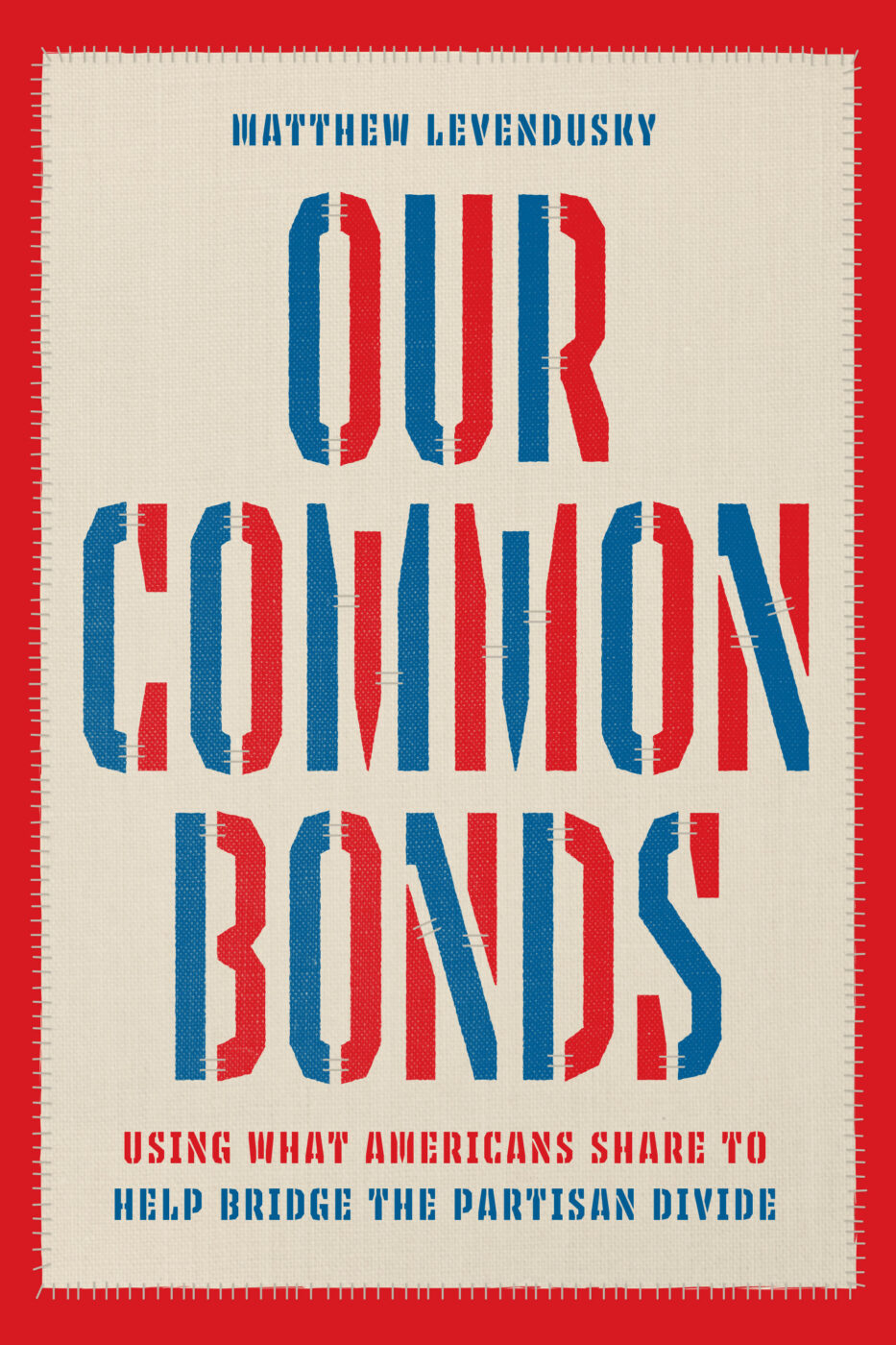In an age of division and polarization, University of Pennsylvania political scientist Matt Levendusky is searching for what we have in common. In his new book “Our Common Bonds: Using What Americans Share to Help Bridge the Partisan Divide” (University of Chicago Press), Levendusky explores strategies to reduce partisan animosity by building on what Republicans and Democrats have in common.
In this interview, Levendusky, a professor in the School of Arts & Sciences and the Stephen and Mary Baran Chair in the Institutions of Democracy at the Annenberg Public Policy Center of the University of Pennsylvania, talks about how to reduce what scholars call “affective polarization” and how to hold a more meaningful conversation with someone who does not share your political views. This interview has been edited for length and clarity.
Question: What is affective polarization?

Matt Levendusky: Affective polarization is the tendency for people to dislike the other side even when they agree on the issues. This has a lot of real-world manifestations. There are people who say they don’t want to be friends with people from the other side [of the political aisle]. They don’t want to have them as roommates or neighbors. They don’t want to do even apolitical activities with them. So, it’s the sense that Democrats and Republicans might not even be willing to interact socially with one another.
Q: And your book, “Our Common Bonds,” is a look at how to decrease that?
ML: The book is looking at trying to find ways that you might reduce some of this animosity. You’re not going to eliminate it, but you might be able to tone it down some and that’s the point of the book. There are a couple of different strategies that I examine in the book. One is priming or making more salient common identities. One [such identity] would be our identity as Americans, although that one can be a little bit complicated because of the recent debates over what it means to be American. A less problematic one might be, for example, sports fandom. Or being from the same college alumni group, or something like that.
[Read an excerpt from “Our Common Bonds” in Penn Today.]
Another strategy would be reminding people that they actually do have friends from the other party. About 8 in 10 of us have some friends from the other party, someone that they know and like and respect. And when you think about that person you know, like, and respect being someone from the other side, your image of them [the other side] changes a little bit. So that’s not just these kinds of crazy people you might see on TV or you might see ranting on Facebook, but it includes someone you know and like. So, a Republican might say, “I know [so-and-so], he’s a Democrat, and he’s a good guy, so maybe not all Democrats are quite so crazy.”
 And then, finally, the third strategy is that you can have civil cross-party dialogues that bring people together. And it’s not so much that people agree in those conversations. In fact, they often don’t. Sometimes they will find that they end up agreeing on more issues than they realize, but the bigger part of it is showing people that those on the other side have some real reasons for their point of view and that they can disagree without being disagreeable.
And then, finally, the third strategy is that you can have civil cross-party dialogues that bring people together. And it’s not so much that people agree in those conversations. In fact, they often don’t. Sometimes they will find that they end up agreeing on more issues than they realize, but the bigger part of it is showing people that those on the other side have some real reasons for their point of view and that they can disagree without being disagreeable.
Take those in turn. Because people don’t often have a good idea of why other people hold the beliefs that they do, they often think, “Oh, there’s no reason why you would believe X. There’s no reason why you would oppose gun control.” But if you meet someone, and you hear their story about why they think that guns are a very important part of their social identity, you might think, “I don’t agree with you, but at least I kind of understand where you’re coming from now.”
Second, people can disagree without it turning ugly and uncomfortable. There’s always the potential for discomfort in those sorts of conversations, but they don’t have to become uncomfortable. Part of why we overestimate how uncomfortable cross-party conversations will be is that the types of people who like to talk about politics all the time are the people who are the most extreme and engaged. So, people tend to think that all conversations are going to be like that when that’s just more accurately a description of talking to someone who is extremely political, which most people are not.
Q: To help remedy this problem, what would you suggest doing?
ML: Having these sorts of broader conversations with other types of people is actually useful. If you just have conversations with more ordinary people, they’re not likely to be so entrenched in their political identities. And they’re not going to be so strident, and you’re going to be able to have more productive conversation with them. But I think part of it is also just learning how to have conversations across lines of difference where we listen to one another, hear what other people have to say and realize, OK, right, I might disagree, but there’s some reasonable grounds for disagreement.
Q: How do you get people to stress their commonalities?
ML: That’s not always so easy. That does take work. There’s nothing easy about any of these strategies. But we can think about one idea that the scholars call identity complexity. We’re all complicated people, we wear a lot of different hats. When we think about the world politically, a lot of people start with their partisanship because that’s in many ways your most salient political identity. But it’s one that, first, tends to put us into conflict with one another, and second, is not the most important identity to most people, unless you’re very politically engaged and politically involved. For most people, yes, your identity as Democrat or Republican or Independent is important to you, but so are other identities, whether that’s as a parent, or homeowner, or spouse, or whatever, which suggests a different way of approaching the problem. So, getting people to think a little bit beyond that Democrat-Republican divide can be a useful way for thinking about what other things they might have in common.
People say, how do you start that kind of conversation? Rather than saying to someone, “What is something that you like about Joe Biden or Donald Trump?” you know you could say, “What’s something where your party really disappoints you and you think that they haven’t done a good job?” And that might open up a space for a conversation that’s interesting and gives us little differences. Or “What’s something where you agree with people on the other side?” Something that facilitates a bit more dialogue rather than kind of collapsing things down to partisan fighting right away.
Q: What kind of research is your book based on?
ML: It’s based on three sets of things. One is a set of surveys. Related to that, second, is a set of survey experiments where we try to prime different types of identities, get people to think about the fact that they have cross-party friendships, and so forth. And then the third was the in-person deliberation experiments that [research collaborator] Dom Stecuła and I did. It seems like a very long time ago, although we did them just before the Covid pandemic. The surveys and experiments allow us to test out these strategies and see which ones work.
Q: How do you bring these strategies into everyday interactions?
ML: One tip is to focus on having more interesting or maybe more meaningful conversations. That starts from asking productive kinds of questions. But I think actually the most important thing I learned from doing all this is the value of listening. And that seems really banal to say but it’s actually quite profound, because we often are thinking about what we’re going to say, centering ourselves in the conversation. But really listening to someone else is hard, and it’s a skill that you have to develop. I’ve learned a lot just from, one, hearing other people’s perspectives, and two, learning that sometimes the most important part of a conversation isn’t giving your perspective, but getting someone else’s. You can benefit from that a lot, just from seeing how someone else thinks.

